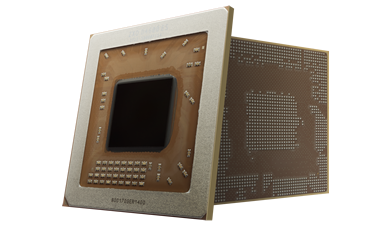Chinese-Produced Zhaoxin KX-6000 CPUs Purportedly Match Intel's Core i5-7400
Late last year, the China-based processor designer Zhaoxin Semiconductor (jointly owned by the Shangai government and VIA Technologies, another semiconductor corporation) promised its upcoming octa-core CPUs based on the 16nm node from TSMC would be able to match Intel's quad-core i5 processors, and today is that day: the newly-announced KX-6000 CPUs are said to deliver performance on par with the Core i5-7400, yet supposedly pull off the feat at a mere 3 GHz. And they support Windows. While this level of performance may not seem very impressive, it is actually a very significant development for a few reasons.
Companies like VIA and Zhaoxin are eager to compete with Intel, AMD, IBM, and others because China wants its own processors, not only to compete within its own borders but also to compete abroad and reduce the country's exposure to outside influence. The international CPU scene is dominated by American companies like Intel, AMD, and IBM, among others. For both political reasons (such as self-determination and independence) and economic reasons, the prospect of China producing and exporting profitable and powerful processors is enticing.
It's also a significant technological achievement for Zhaoxin. Any kind of CPU that can compete with Intel on any field is impressive since Intel is at the top of the hierarchy in both size and technology. Intel's traditional rival AMD and the more server- and specialist-focused IBM are Intel's only real competition; it would certainly shake up the dynamic if Zhaoxin could field competitive processors for the x86 market. The Core i5-7400 isn't Intel's fastest desktop CPU by any means (not even when it launched in 2017), but it is one of the fastest desktop CPUs made by any company today. Even AMD's first-gen Ryzen CPUs struggled against it in single-threaded workloads.
Lenovo already uses previous-gen Zhoaxin processors in some notebooks, and benchmarks have popped up in public databases, meaning the chips are more than just a pipe dream. Zhaoxin is also similarly planning on launching competitive server CPUs (the KH-40000 series), but on the 7nm node from TSMC with PCIe 4.0 and DDR5 support. Zhaoxin hasn't said exactly when these CPUs would arrive, but it will be a little while since it is slated to use upcoming DDR5 memory.
Get Tom's Hardware's best news and in-depth reviews, straight to your inbox.

Matthew Connatser is a freelancing writer for Tom's Hardware US. He writes articles about CPUs, GPUs, SSDs, and computers in general.
-
rinosaur This is a huge development and can't be understated. Chinese owned/produced, legitimate x86 licensed, and runs x86 Windows with very respectable performance... enough said.Reply -
jimmysmitty Replyrinosaur said:This is a huge development and can't be understated. Chinese owned/produced, legitimate x86 licensed, and runs x86 Windows with very respectable performance... enough said.
Minus the hardware built in spyware. Since its co-developed by a government owned entity I wouldn't go anywhere near it. -
GetSmart These were actually VIA (also formerly Cyrix) chips, and designed by Centaur Technology. That is where that x86 licensed comes from. That KX-6000 is actually an octa-core CPU. Can find other benchmarks here https://browser.geekbench.com/v4/cpu/search?q=ZHAOXIN+KaiXian The IPC of this falls roughly around Intel's Goldmont in Intel's Apollo Lake SoC.Reply -
Finstar Replyjimmysmitty said:Minus the hardware built in spyware. Since its co-developed by a government owned entity I wouldn't go anywhere near it.
You know Intel and AMD have those too? Only difference is that NSA controls the backdoors.
I guess that's absolutely fine though because reasons. -
jimmysmitty ReplyFinstar said:You know Intel and AMD have those too? Only difference is that NSA controls the backdoors.
I guess that's absolutely fine though because reasons.
The big difference is that AMD and Intel are not government owned. That makes a massive difference alone.
As for backdoors, sure. Everything has them but again the less government owned the better. -
hrlincon I doubt this advancement came without intellectual property theft. AMD, INTEL, IBM need to do their due diligence.Reply -
jimmysmitty Replyhrlincon said:I doubt this advancement came without intellectual property theft. AMD, INTEL, IBM need to do their due diligence.
It was done with VIA so it probably was legitimate although I am not sure if VIAs license allows them to share the x86 IP with others, especially China where a lot of IP is heavily restricted. Not too long ago China had another CPU, the Loongson, that was their own CPU design using MIPS but had to emulate x86 and was very far from AMD or Intel in performance. -
GetSmart Reply
Zhaoxin Semiconductor is a joint venture between VIA Technologies and the Shanghai Municipal Government. As mentioned earlier, the CPU architecture is designed by Centaur Technology.hrlincon said:I doubt this advancement came without intellectual property theft. AMD, INTEL, IBM need to do their due diligence. -
Finstar Replyjimmysmitty said:The big difference is that AMD and Intel are not government owned. That makes a massive difference alone.
As for backdoors, sure. Everything has them but again the less government owned the better.
US government still very much has control over American companies. Remember what happened between Google and Huawei not too long ago?
They're causing hysteria by accusing others of doing something they themselves have been caught doing for years now. -
bit_user Reply
Source?Finstar said:You know Intel and AMD have those too? Only difference is that NSA controls the backdoors.
I guess that's absolutely fine though because reasons.
There's no legal framework for the US government to mandate backdoors in US-made technology products. Were such a law to exist, it would probably be found unconstitutional.
I'm not saying it never happened, but I don't think it would happen today. The lack of such intentional backdoors is why the NSA hoards what hacks and security flaws it finds, without telling anyone who could fix them.

